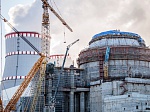30.09.2019
INFORMATION AND PUBLIC RELATIONS DEPARTMENT OF LENINGRAD NPP
The most powerful electric engines have been successfully tested at the VVER-1200 2nd power block of the Leningrad NPP-2
The verification of two out of four electric engines of the primary circulation pumping assemblies located at the reactor hall of the innovative VVER-1200 2nd power block has been successfully completed at the Leningrad NPP-2.
The equipment trial was run at idle speed. At first, the specialists launched each electric engine for a short period of time to define the direction of rotation. At the next stage, the electric engines were spinning for 15 minutes in order to measure the vibrations and to verify the automated control operation. In order to fully confirm the main parameters, the final stage took 6 hours.
‘The tests at idle went successfully. We have proven that the electric engines have been properly assembled, they are functional and work in a stable manner. During the test run, no unwanted sounds, vibrations, defects or failures were detected. All measurable and controllable parameters were confirmed and are within the working values’, Alexander Belyaev, the chief engineer at the Leningrad NPP-2, said.
Once all other electric engines are verified at idle, they will be connected to the circulation pumps, and the machinery will be tested at load.
The primary circulation pumping assemblies are key high-powered pieces of equipment (over 7,000 kW each). When in operation, they will have to pump at least 80,000 cubic meters of heat transfer agent per hour through the reactor core.
Shortly, the primary circulation pumping assemblies will be used during all major operations held at the power block during the pre-launch adjustment works, including the circulation flushing of the reactor facility primary circuit and equipment hot trial.
The Leningrad NPP is the country’s first plant with RBMK-1000 reactors (uranium-graphite circuit-type reactor running on thermal neutrons). The decision that marked its construction was taken in September 1966 by a resolution of the Central Committee of the Communist Party of the USSR and the Council of Ministers No. 800-252. According to that document, the Leningrad NPP was supposed to become a core in a network of nuclear power plants with RBMK-1000 reactors that were supposed to produce a substantial share of electric power. The construction of the Leningrad NPP was going well, and by 1973 the first power block was fully erected. On December 23, 1973, following stable 72-hours’ operation at the capacity of 150 megawatt, the State Commission signed the acceptance certificate stating that the first power block of the Leningrad nuclear power plant is commissioned for pilot production.


 career
career Innovations
Innovations Projects
Projects INTERNATIONAL BUSINESS
INTERNATIONAL BUSINESS